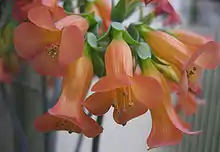Kalanchoe delagoensis
Kalanchoe delagoensis, formerly known as Bryophyllum delagoense[2] and commonly called mother of millions or Chandelier plant,[3] is a succulent plant native to Madagascar. Like other members of Bryophyllum (now included in Kalanchoe[1]), it is able to propagate vegetatively from plantlets that develop on its leaf margins.
| Kalanchoe delagoensis | |
|---|---|
 | |
| Flowers | |
| Scientific classification | |
| Kingdom: | Plantae |
| Clade: | Tracheophytes |
| Clade: | Angiosperms |
| Clade: | Eudicots |
| Order: | Saxifragales |
| Family: | Crassulaceae |
| Genus: | Kalanchoe |
| Species: | K. delagoensis |
| Binomial name | |
| Kalanchoe delagoensis | |
| Synonyms[1] | |
| |
.jpg.webp)
This species' capability for vegetative reproduction, its drought tolerance, and its popularity as a garden plant, relate to this species' becoming an invasive weed in places such as eastern Australia and many Pacific islands. In the Neotropics hummingbirds sometimes pollinate this non-native plant.[4]
Kalanchoe delagoensis is unwelcome because it displaces native plants and contains bufadienolide cardiac glycosides[5] which can cause fatal poisoning, particularly in grazing animals like cattle.[6] During 1997, 125 head of cattle died after eating this species on a travelling stock reserve near Moree, NSW.[7]
In the Australian states of New South Wales[8] and Queensland,[9] this species and its hybrids have been declared a noxious weed.
Footnotes
- "Kalanchoe delagoensis Eckl. & Zeyh". Plants of the World Online. Kew Science. Retrieved 2020-10-14.
- Rafter, M.A.; Gillions, R.M.; Walter, G.H. (2008). "Generalist herbivores in weed biological control—A natural experiment with a reportedly polyphagous thrips". Biological Control. Elsevier BV. 44 (2): 188–195. doi:10.1016/j.biocontrol.2007.09.011. ISSN 1049-9644.
- "Kalanchoe delagoensis". Germplasm Resources Information Network (GRIN). Agricultural Research Service (ARS), United States Department of Agriculture (USDA).
- For example sapphire-spangled emerald (Amazilia lactea) in Brazil (Baza Mendonça & dos Anjos 2005)
- Bryotoxins A, B and C: McKenzie et al. (1987), Steyn & van Heerden (1998)
- McKenzie & Dunster (1986), McKenzie et al. (1987)
- les tanner. "North West Weeds". Northwestweeds.nsw.gov.au. Archived from the original on 2009-06-21. Retrieved 2013-02-19.
- "The New South Wales Government WeedWise Resource".
- "The Queensland Government Resource on invasive plants".
References
| Wikimedia Commons has media related to: |
| Wikispecies has information related to Kalanchoe delagoensis. |
- Baza Mendonça, Luciana & dos Anjos, Luiz (2005): Beija-flores (Aves, Trochilidae) e seus recursos florais em uma área urbana do Sul do Brasil [Hummingbirds (Aves, Trochilidae) and their flowers in an urban area of southern Brazil]. [Portuguese with English abstract] Revista Brasileira de Zoologia 22(1): 51–59. doi:10.1590/S0101-81752005000100007 PDF fulltext
- McKenzie, R.A. & Dunster, P.J. (1986): Hearts and flowers: Bryophyllum poisoning of cattle. Australian Veterinary Journal 63(7): 222-227. doi:10.1111/j.1751-0813.1986.tb03000.x PMID 3778371 (HTML abstract)
- McKenzie, R.A.; Franke, F.P. & Dunster, P.J. (1987): The toxicity to cattle and bufadienolide content of six Bryophyllum species. Australian Veterinary Journal 64(10): 298-301. doi:10.1111/j.1751-0813.1987.tb07330.x PMID 3439945 (HTML abstract)
- Steyn, Pieter S & van Heerden, Fanie R. (1998): Bufadienolides of plant and animal origin. Nat. Prod. Rep. 15(4): 397-413. doi:10.1039/a815397y PDF fulltext
